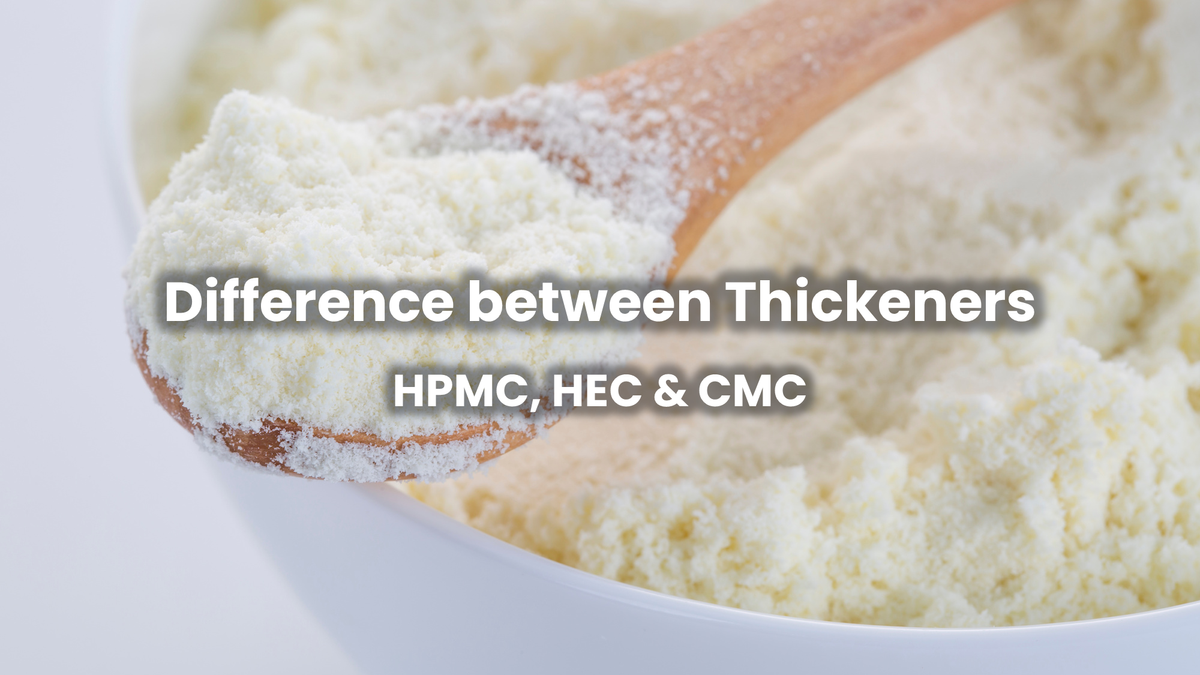
Thickeners are widely used in many industries, including personal care, construction, paint, food and pharmaceuticals. Among the many options available, three commonly used water-soluble cellulose-based thickeners are Hydroxypropyl Methylcellulose (HPMC), Hydroxyethyl Cellulose (HEC), and Carboxymethyl Cellulose (CMC). These thickeners come from modified cellulose and serve similar purposes, but they are not interchangeable due to differences in chemistry, solubility, viscosity behaviour, compatibility and final application.
In this article, we will explore how HPMC, HEC and CMC function in household products, compare their performance and help you understand which one is best suited for specific applications.
What Are Cellulose-Based Thickeners?
Cellulose is a natural polymer found in plant cell walls. When chemically modified, it becomes water-soluble and gains functional properties like thickening, stabilizing or film-forming. HPMC, HEC and CMC are all cellulose ethers, but each one has a different substitution group that affects its behaviour.
What Are HPMC, HEC, and CMC?
Before comparing their uses, let's briefly understand what these three chemicals are.
Hydroxypropyl Methylcellulose (HPMC)
HPMC is a non-ionic cellulose ether modified with hydroxypropyl and methyl groups. It has excellent thickening, water retention and film-forming properties, making it widely used in household cleaners, personal care products and coatings.
Hydroxyethyl Cellulose (HEC)
HEC is another non-ionic cellulose ether, modified with hydroxyethyl groups. It dissolves easily in water and provides good viscosity control, stability and suspension properties. HEC is commonly found in liquid detergents, shampoos and water-based paints.
Carboxymethyl Cellulose (CMC)
CMC is an anionic cellulose ether modified with carboxymethyl groups. It is known for its high solubility in water and excellent thickening, stabilizing and binding properties. CMC is widely used in laundry detergents, dishwashing liquids, toothpaste and even food products.
Comparison of HPMC, HEC, and CMC in Household Applications
Feature | HPMC | HEC | CMC |
Ionic Nature | Non-ionic | Non-ionic | Anionic |
Water Solubility | Soluble in cold water (slow hydration) | Soluble in cold water | Soluble in cold water (fast hydration) |
Thickening Ability | Moderate to high | High | Moderate |
Film-Forming Property | Strong | Moderate | Weak |
Water Retention | Excellent | Good | Moderate |
Common Household Uses | Tile adhesives, detergents, cosmetics | Paints, shampoos, liquid cleaners | Laundry detergents, dishwashing liquids, toothpaste |
Uses of HPMC, HEC, and CMC in Household Products
Household Cleaners and Detergents
Thickeners play a crucial role in liquid detergents, surface cleaners, and dishwashing liquids by improving viscosity, stability, and foaming properties.
- HPMC: Used in multi-purpose cleaners and disinfectants due to its water retention and film-forming properties.
- HEC: Commonly used in liquid detergents and dishwashing liquids, as it provides a smooth flow and helps suspend particles.
- CMC: Frequently used in laundry detergents to enhance viscosity and prevent dirt from redepositing on clothes.
Which is best for detergents?
- For laundry detergents, CMC is a good choice due to its anionic nature, which interacts well with surfactants.
- For liquid detergents, HEC is preferred as it enhances the stability apart from providing excellent flow and consistency.
- For household surface cleaners, HPMC is effective due to its film-forming ability.
Personal Care Products (Shampoos, Lotions, and Toothpaste)
Cellulose thickeners are widely used in cosmetics, skincare and oral care products for thickening, stability and moisture retention.
- HPMC: Used in skincare products, face creams and lotions for water retention and smooth application.
- HEC: Commonly used in shampoos and body washes to create a thick, luxurious texture.
- CMC: Found in toothpaste due to its ability to bind ingredients and provide a smooth consistency.
Which is best for personal care?
- For shampoos, HEC is the best option as it provides a rich texture without excessive foaming.
- For toothpaste, CMC is commonly used due to its excellent binding ability.
- For skincare products, HPMC is often chosen for its hydrating and film-forming properties.
Paints and Coatings
Thickeners are essential in water-based paints to control viscosity, improve stability and prevent pigment settling.
- HPMC: Used in wall paints and coatings for its thickening and film-forming properties.
- HEC: Preferred in water-based paints due to its excellent solubility and viscosity control.
- CMC: Occasionally used in specialized coatings but not as common in regular household paints.
Which is best for paints?
- HEC is the best thickener for water-based paints, as it provides excellent viscosity control without affecting the paint's drying time.
- HPMC can be used in coatings that require a strong film-forming ability.
Key Factors to Consider When Choosing a Thickener
When selecting the right thickener for household applications, consider the following:
- Water solubility: HEC and CMC dissolve faster than HPMC.
- Ionic nature: CMC (anionic) interacts with surfactants, while HPMC and HEC (non-ionic) are more stable in different formulations.
- Viscosity requirements: HEC provides the highest viscosity, followed by HPMC, while CMC has moderate thickening ability.
- Film-forming ability: HPMC is best for applications requiring a strong film, such as coatings and adhesives.
- Application-specific needs: CMC is preferred for detergents and toothpaste, HEC for shampoos and paints, and HPMC for adhesives and coatings.
Storage and Handling Tips
- Always store in a dry environment, as cellulose ethers can absorb moisture.
- Use gradual stirring when dissolving to avoid lump formation.
- Always check compatibility with other ingredients, especially salts or acids.
Conclusion
HPMC, HEC and CMC are all useful thickeners in household applications, but their differences in chemical structure, solubility and performance make them suitable for specific uses. HPMC is best for construction materials, household cleaners and skincare products. HEC is widely used in paints, shampoos and liquid detergents. CMC is commonly found in laundry detergents, dishwashing liquids and toothpaste. Choosing the right thickener ensures better stability, texture and performance in household products. If you are formulating a product and need guidance, consider the key differences outlined in this article to make the best choice.






